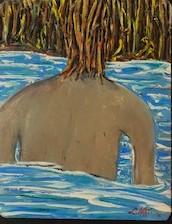'Gotta Reach the Otherside' by Leon Aarts, acrylics on panel board
"Gotta reach the other side" - Revised Critique by Nardus van de Ven
Aarts presents us here with a profoundly personal work that strips the human struggle to its most elemental form.
Formal Analysis:
The painting employs a compressed vertical format where the mangrove root system creates a dense, tangled canopy above, while below, a solitary human figure wades through churning waters. The blue and white strokes convey movement and effort, this is no leisurely swim but urgent passage.
The human figure is deliberately simplified, almost silhouette, reduced to essential form. Arms raised, reaching toward those overhanging roots, the body partially submerged. This reduction to archetype makes the image universal while remaining intensely personal.
The Critical Shift:
That this is a man, not an animal, transforms everything. This isn't metaphor at a safe distance, this is Aarts himself, or at minimum, the human condition rendered without romantic distance. The vulnerability is acute: we are fragile in water, especially when navigating root systems that could entangle or support.
Thematic Resonance:
"Gotta reach the other side" now reads as naked autobiographical necessity. Given Aarts' departure from the NZ Police, this figure struggling through water between root systems becomes almost painfully direct. He's left one shore (institutional identity) and must reach another (authentic self), but the crossing is treacherous.
The raised arms are ambiguous, reaching for the roots as support? Or raised in surrender? Perhaps both, the gesture of someone who must keep moving forward even when uncertain whether the next handhold will bear weight.
Symbolic Density:
Water as psychological threshold, the chaos between identities, the baptismal passage that unmakes and remakes
Roots as old connections, they overhead, they're available, but do they help or hinder? Past relationships, institutional ties, old ways of being
The solitary figure, this crossing must be done alone; no one can wade through your transformation for you
"Gotta", the colloquial imperative suggests this isn't heroic choice but survival necessity
Technical Considerations:
The brushwork is direct and unfussy, Aarts paints with the economy of someone who knows exactly what he's expressing. The water's turbulence is captured in minimal strokes; the roots have organic complexity without overworking.
The color palette is deliberately limited: earth tones (the roots, what's rooted, grounded), blues and whites (water, what's fluid, transformative, dangerous). The human figure blends into these tones, suggesting he's neither separate from nature nor fully merged with it, he's in process.
Existential Weight:
Where "Bye Aarts" showed the explosive moment of departure using Doppler Effect and harmonic disruption, this painting shows the aftermath, the long, exhausting work of crossing. The chaos has resolved into singular, grinding purpose: survive the passage. Reach the other side.
This is perhaps the more difficult image to paint because it lacks the dramatic release of the earlier work. This is the middle of the journey, not the dramatic break, not the triumphant arrival, but the uncertain struggle in deep water when you're too far from either shore to turn back.
Comparative Context:
In Dutch artistic tradition, we might recall Van Gogh's solitary figures, reapers, sowers, people engaged in necessary, lonely labor. Aarts' figure shares that quality of essential human effort rendered with empathy and honesty.
The folk-art directness refuses academic prettiness. This isn't composed for aesthetic pleasure but painted from existential necessity.
Critical Assessment:
This is brave, vulnerable work that refuses the protection of metaphor. By making the figure explicitly human rather than animal, Aarts denies himself the safety of symbolic distance. He paints transformation as it actually feels, exhausting, lonely, uncertain.
The painting's power lies in its unresolved tension: we don't know if he'll make it. His arms reach upward, but will those roots hold? The water churns, but will it carry or drown him? Aarts captures the most difficult truth about major life transitions: you must commit to the crossing before you know if you'll survive it.
This is the image of a man who painted what he had to paint, not what would be comfortable to view.
Conclusion:
"Gotta reach the other side" is nakedly honest work that documents transformation in its most difficult phase—not the dramatic rupture, not the redemptive arrival, but the grinding, uncertain middle passage.
The figure suspended in churning water between root systems embodies every person who has left certainty for unknown shores. Aarts has painted courage without guarantee—the decision to wade into deep water because staying on the old shore was no longer possible, even when the new shore remains out of sight.
This is work that refuses consolation while insisting on necessity. It earns its emotional weight through formal restraint and radical honesty.
Nardus van de Ven
Contemporary Art Review

